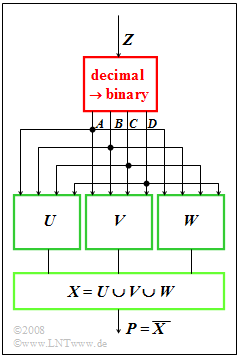Exercise 1.2: Decimal/Binary Converter
From LNTwww
A number generator $Z$ supplies decimal values in the range $1$ to $15$.
- These are converted into binary numbers (block outlined in red).
- The output consists of the four binary values $A$, $B$, $C$ and $D$ with decreasing significance.
- For example $Z = 11$ delivers the binary values
- $$ A = 1, \ B = 0, \ C = 1, \ D = 1. $$
Set-theoretically, this can be represented as follows:
- $$ Z = 11\qquad\widehat{=}\qquad A \cap\overline{ B} \cap C \cap D.$$
Three more Boolean expressions are formed from the binary quantities $A$, $B$, $C$ and $D$ and their union set is denoted $X$ :
- \[ U = A \cap \overline{D} \]
- \[ V = \overline{A} \cap B \cap \overline{D} \]
- $$W,\; {\rm where} \; \, \overline{W} = \overline{A} \cup \overline{D} \cup (\overline{B} \cap C) \cup (B \cap \overline{C}). $$
- Note that $Z = 0 \ ⇒ \ A = B = C = D = 0$ is already excluded by the number generator.
- Note also that not all input quantities $A$, $B$, $C$ and $D$ are used to calculate all intermediate quantities $U$, $V$ and $W$, resp.
Hints:
- The exercise belongs to the chapter Set theory basic.
- The topic of this chapter is illustrated with examples in the (German language) learning video:
- "Mengentheoretische Begriffe und Gesetzmäßigkeiten" ⇒ "Set-theoretical terms and laws".
Questions
Solution
(1) The event $U$ contains
- those numbers greater/equal to eight $(A = 1)$,
- which are even $(D = 0)$: $8, 10, 12, 14$
⇒ Proposed solutions 2 and 4 are correct.
(2) The event $V$ consists of the two numbers $4$ (binary 0100) and $6$ (binary 0110) ⇒ The correct solutions are 1 and 3.
(3) For the event $W$, de Morgan's theorem holds:
- $$\overline W = \overline A \cup \overline D \cup (\overline B \cap C) \cup (B \cap \overline C) \hspace{0.3cm} \Rightarrow \hspace{0.3cm} W = \overline{\overline W} = A \cap D \cap (\overline{\overline B \cap C}) \cap (\overline{B \cap \overline C}).$$
- Using de Morgan's theorems, it further follows:
- $$ W = A \cap D \cap (B \cup \overline C) \cap (\overline B \cup C).$$
- Finally, using the Boolean relation $(B \cup \overline C) \cap (\overline B \cup C) = (B \cap C) \cup (\overline B \cap \overline C)$ we obtain (see sketch):
- $$W = (A \cap B \cap C \cap D) \cup (A \cap \overline B \cap \overline C \cap D).$$
- Thus, $W$ contains the numbers $15$ and $9$ ⇒ only the proposed solution 1 is correct.
(4) The union of $U$, $V$ and $W$ contains the following numbers: $4, 6, 8, 9, 10, 12, 14, 15$.
- Accordingly, the set $P$ as the complement of this union is:
- $$P = {\{1, 2, 3, 5, 7, 11, 13\}}.$$
- These are exactly the prime numbers which can be represented with four bits ⇒ Proposed solution 2.

